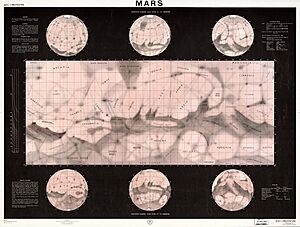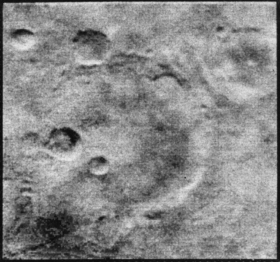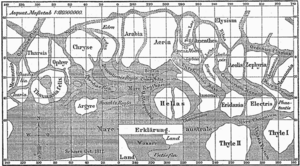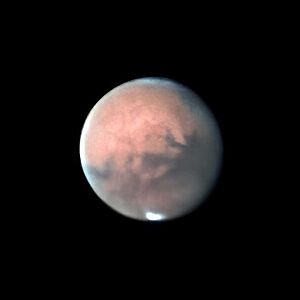Martian canals facts for kids

For a long time, people thought there were "canals" on the planet Mars. These were seen as long, straight lines across Mars's middle parts. Astronomers using early telescopes without cameras first observed them.
The Italian astronomer Giovanni Schiaparelli first described these lines in 1877. He called them canali, which means "channels" in Italian. But this word was wrongly translated into English as "canals." Other astronomers later reported seeing them too.
Some people even thought these lines were huge irrigation canals built by intelligent aliens living on Mars. But by the early 1900s, better observations showed that the "canals" were just an optical illusion. Today, spacecraft have mapped Mars in high detail. These maps show that no such features exist on the planet's surface.
How the "Canals" Were "Discovered"
The Italian word canale can mean "canal," "channel," or "gully." The first person to use this word for Mars was Angelo Secchi in 1858. However, he didn't see straight lines. He used the term for large features, like "Canale Atlantico" for what we now call Syrtis Major Planum. Schiaparelli and others named the supposed canals after rivers on Earth or from myths.
In the late 1800s, astronomers observed planets without cameras. They had to look through telescopes for hours. They waited for moments when the air was still and the image was clear. Then, they would draw what they saw.
Astronomers at the time thought Mars had a thick atmosphere. They knew Mars's day length was similar to Earth's. They also knew Mars's tilt was like Earth's, meaning it had seasons. They could see Mars's polar ice caps grow and shrink with the seasons. These similarities made them think that darker areas on Mars were oceans. But by the late 1920s, scientists learned Mars is very dry. It also has a very thin atmosphere.
In 1889, American astronomer Charles A. Young said that Schiaparelli's canals were confirmed. But new canals had appeared where there were none before. This raised "important and perplexing" questions about how they formed.
During a good viewing period in 1892, W. H. Pickering saw many small, dark, round spots. These spots were at the intersections or starting points of the "canals." Schiaparelli had seen some of these as larger dark patches. He called them seas or lakes. Pickering's observatory was high up in Peru, which gave him very clear views. Other observers, especially Percival Lowell, soon saw these spots too.
Reports in 1892 and 1894 mentioned seasonal color changes. As the polar snows melted, the nearby "seas" seemed to spread out. They sometimes looked green. Around 1894, people started to doubt if there were any seas on Mars at all. Under the best viewing conditions, these supposed 'seas' looked uneven. They appeared like a mountainous area with ridges and canyons, seen from high above. These doubts soon became certainties. Now, everyone agrees that Mars has no permanent bodies of surface water.
Doubts and the Final Proof

Not all astronomers agreed about the canals. A well-known observer named Eugène Antoniadi used a large telescope in 1909. He saw no canals on Mars. Amazing photos of Mars taken at the Pic du Midi observatory also showed that the Martian canals theory was wrong in 1909. The idea of canals then started to lose support. Around this time, studies of light (spectroscopic analysis) also showed no water in Mars's atmosphere. However, as late as 1916, Waldemar Kaempffert, an editor for Scientific American, still strongly defended the canal theory.
In 1907, the British naturalist Alfred Russel Wallace wrote a book called Is Mars Habitable? He strongly disagreed with Lowell's claims. Wallace's studies showed that Mars was much colder than Lowell thought. Also, the air pressure was too low for liquid water to exist on the surface. He also noted that recent attempts to find water vapor in Mars's atmosphere had failed. He concluded that complex life was impossible on Mars. This meant that a planet-wide irrigation system, as Lowell claimed, could not exist.
The idea of Martian canals was still debated even when the Space Race began. In 1965, a science book said that most astronomers probably agreed there were linear markings on Mars. These marks were thought to be 40 to 160 kilometers (25 to 100 miles) wide and very long.
But later that same year, the United States' Mariner 4 spacecraft arrived at Mars. It took pictures that finally proved Mars could not support higher forms of life. It also showed that no canal features existed. The pictures revealed impact craters and a mostly barren landscape. Mariner 4 measured very low air pressure, only 0.4% to 0.7% of Earth's. Daytime temperatures were around -100 degrees Celsius. No magnetic field or radiation belts were found.
As early as 1903, Joseph Edward Evans and Edward Maunder did experiments with schoolboys. They showed how the canals could appear as an optical illusion. When a poor telescope views many small dots (like sunspots or craters), they can seem to connect and form lines. Lowell's assistant, A. E. Douglass, explained the observations as a trick of the mind. Later, William Kenneth Hartmann, a Mars imaging scientist, thought the "canals" might have been streaks of dust. These streaks could have been caused by wind on the side of mountains and craters that is sheltered from the wind (the leeward side).
See also
 In Spanish: Canales de Marte para niños
In Spanish: Canales de Marte para niños
- Classical albedo features on Mars
- Face on Mars
- History of Mars observation
- Life on Mars
- Lineae
- Outflow channel
- Solis Lacus
- Valley networks (Mars)
- Water on Mars



